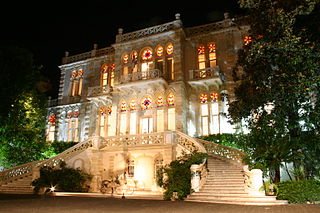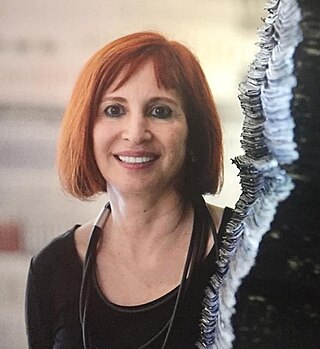
Beirut is the capital and largest city of Lebanon. As of 2014, Greater Beirut has a population of 2.5 million, which makes it the third-largest city in the Levant region and the thirteenth-largest in the Arab world. The city is situated on a peninsula at the midpoint of Lebanon's Mediterranean coast. Beirut has been inhabited for more than 5,000 years, making it one of the oldest cities in the world.

Achrafieh is an upper-class area in eastern Beirut, Lebanon. In strictly administrative terms, the name refers to a sector (secteur) centred on Sassine Square, the highest point in the city, as well as a broader quarter (quartier). In popular parlance, however, Achrafieh refers to the whole hill that rises above Gemmayze in the north and extends to Badaro in the south, and includes the Rmeil quarter.

Sursock Palace, is a grand residence located on Rue Sursock in the city of Beirut, Lebanon. The palace, which was completed in 1860 by Moïse Sursock, was owned by Lady Cochrane Sursock, an advocate of preserving historic buildings in Lebanon.

The Sursock Museum, officially known as the Nicolas Ibrahim Sursock Museum, is a modern and contemporary art museum in Beirut, Lebanon.

Nicolas Sursock (1875–1952) was a Lebanese art collector and a prominent member of the Sursock family, one of the old aristocratic families of Beirut.
Rue Sursock is a historic street in the Rmeil district of Beirut in Lebanon. Named after one of Beirut's most prominent families, the Sursock family, the street is home to many of Beirut's beautiful historic mansions that were built in the 18th and 19th centuries by aristocratic families, such as the Sursock and Bustros families. A large gate used to close down Rue Sursock at 10 pm, and this tradition remained until 1945.

The Sursock family is a Greek Orthodox Christian family from Lebanon, and used to be one of the most important families of Beirut. Having originated in Constantinople during the Byzantine Empire, the family has lived in Beirut since 1712, when their forefather Jabbour Aoun left the village of Berbara. After the turn of the 19th century, they began to establish significant positions of power within the Ottoman Empire. The family, through lucrative business ventures, savvy political maneuvering, and strategic marriages, embarked on what Leila Fawaz called "the most spectacular social climb of the nineteenth century," and, at their peak, had built a close network of relations to the families of Egyptian, French, Irish, Russian, Italian and German aristocracies, alongside a manufacturing and distribution empire spanning the Mediterranean.

Rue Gouraud is a mixed residential and commercial street in Gemmayzeh, a neighborhood in the Rmeil district of Beirut in Lebanon. It is named after French General Henri Gouraud. Gemmayze, and Rue Gouraud specifically, and competes with the trendy village-type neighborhood of Badaro, as one of Beirut's bohemian quarters. the district is full of narrow streets and historic buildings from the French era. The neighborhood is well known today for its trendy bars and pubs, cafes, restaurants and lounges, most of which are directly located on Rue Gouraud.
Rue Gouraud is known especially for its culinary scene that is popular with Beirut's fashionistas. The street runs east of Beirut Central District and the Saifi Village, extending from Avenue Georges Haddad and reaching the Corniche du Fleuve. In 2004, Travel + Leisure magazine called the street "SoHo by the Sea," due to its colorful and chic cafés amid 1950's apartment buildings and hole-in-the-wall shops.

Tarek Mitri is a Lebanese university professor, independent politician and former government minister.

Rmeil is one of the neighborhoods of Beirut, the capital of Lebanon. It is located near Ashrafieh, Medawar and Saifi. The neighborhood is known for its Greek Orthodox churches such as Saint Georges and Saint Nicolas. Cultural areas are located in Rmeil, like the Sursock Museum.
Hanibal Srouji is a Lebanese painter. He graduated in 1987 from Concordia University, Montreal. He lived in Canada and France before returning in his country. Srouji developed a technique of burning holes in his paintings after having participated to numerous workshops in America and Europe, including the Triangle Arts Trust. He currently teaches at the Lebanese American University.
Aref El Rayess was a Lebanese painter and sculptor.
Rafic Charaf was a Lebanese painter. He studied at the Académie Libanaise des Beaux-Arts ALBA and, in 1955, obtained a scholarship from the Spanish government and went at the Real Academia de Bellas Artes de San Fernando in Madrid before returning to Lebanon.

The Fernaine family is a prominent Antiochian Greek-Orthodox Christian Lebanese family. It is one of the original Beirut aristocratic “seven Families” along with the Bustros, Abou Saleh, Rebeiz, Fayad, Sursock, Trad, Merhie and Tueni families, who constituted the traditional high society of Beirut for a long time. Estate holders and feudal lords by origin, today they are business owners, physicians, artists, and philanthropists in Lebanon and abroad.
Chucrallah Fattouh is a Lebanese painter. He was born in Monsef, Byblos, and graduated from the Lebanese University’s Faculty of Fine Arts in 1983.
Mouna Bassili Sehnaoui is a Lebanese painter, writer and artist.
Abdul Rahman Katanani is a Palestinian sculptor. He was born and living in Sabra refugee camp in Beirut, Lebanon. Katanani is a third generation Palestinian refugee; his grandparents left Yazour—a small town now called Azor—in Jaffa during the 1948 Palestinian exodus.
Seta Manoukian (1945) is a Lebanese painter of Armenian descent.
Chawky Frenn is a Lebanese-born American artist, author, and art professor. He currently teaches art at George Mason University in northern Virginia. His highly realistic paintings have strong narrative social and political elements. Frenn is a former Fulbright scholar, and currently resides in the Greater Washington, D.C. area.

Nada Sehnaoui is a visual artist and political activist. Her artworks, spanning painting, mixed media works, sculpture and installations, have been widely exhibited internationally, and have been featured in the press and print publications worldwide.











